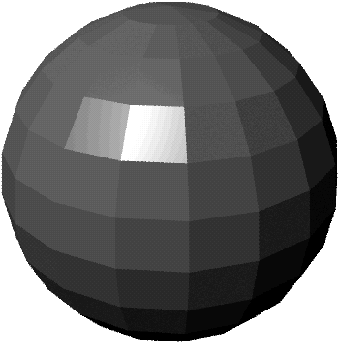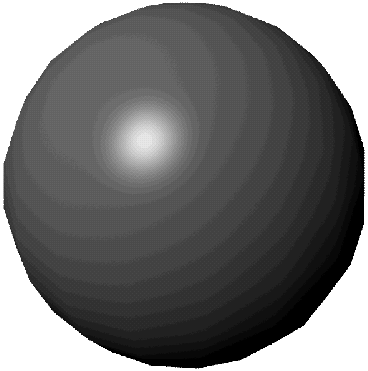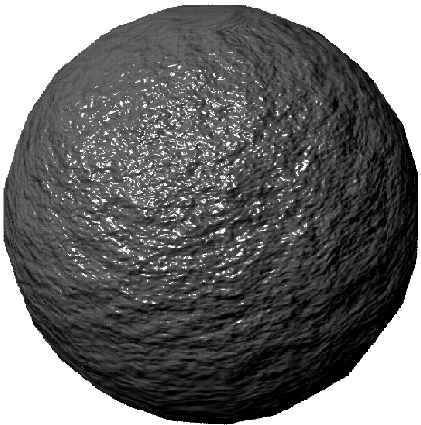A Brief History of How Maya Came to Be
| |
| While we're on the subject of history, take a look at what has led to the current state of computer graphics in general and Maya in particular. It will give you some perspective for the choices made in Maya's design. The "Olden Days"Electronic computers have been with us since the 1940s, but have been applied to imaging for aesthetics only recently. By the 1950s the idea of combining technology with visuals could be seen in television, oscilloscopes, and radar screens. The first major step was probably Ivan Sutherland's Sketchpad electronic drawing system, created in 1961. This vector-based system worked with a lightpen, allowing users to create art directly on a display screen. Vector graphics are primitive line art, common in early video games and movie effects. In 1967 Sutherland joined David Evans at the University of Utah to create a computer graphics curriculum that merged art and science. The university developed a reputation for computer graphics research and attracted some of the future principle players in the CG business: Jim Clark, founder of Silicon Graphics, Inc. (SGI, today the parent company of AliasWavefront); Ed Catmull, an early developer of computer-animated movies; and John Warnock, founder of Adobe Systems, developers of such industry-defining products as Photoshop and Postscript. Algorithms, Invented and ImprovedCG pioneers developed the 3D concept: using a computer to form a perspective drawing from whatever theoretical set of geometry was entered ”usually triangles , but sometimes spheres or paraboloids. The geometry was depicted as solid, with foreground geometry obscuring background geometry. Next came the creation of virtual "lights," producing flat-shaded 3D elements that gave the earliest computer graphics a hard-edged, technical look (see Figure I.1). Figure I.1. Rendered polygons. Averaging the shading from corner to corner produced a smoother look, an innovation called Gouraud shading (for its inventor , Henri Gouraud). This form of smoothing polygons is computationally minimal and is used for real-time smoothing in most 3D video cards today (see Figure I.2). When Gouraud proposed it in 1971, computers could render only the simplest scenes at a glacial pace. Figure I.2. Gouraud shading achieves a smoother look. In 1974, Ed Catmull introduced the concept of the Z-buffer ”the idea that if an image has horizontal (X) and vertical (Y) picture elements, each element could also have depth embedded. This concept speeds the removing of hidden surfaces and is now standard in real-time 3D video cards. Catmull's other innovation was wrapping a 2D image onto 3D geometry. Texture mapping , as shown in Figure I.3, is fundamental to attempting realism in 3D. Before texture mapping, objects had only one solid color , so creating a brick wall might require each brick and bit of grout to be modeled individually. Now, by applying a bitmap image of brick to a simple rectangular object, you can build a wall with minimal computation and computer memory, not to mention less frustration for the animator. Figure I.3. Texture mapping ”applying a 2D texture to a 3D surface. Bui-Toung Phong improved on Gouraud shading in 1974 by interpolating shading across the entire polygon instead of simply using the corners (see Figure I.4). Although this render method can be up to 100 times slower than Gouraud shading, it yields the hyper-real "plastic" look that characterized early computer animation. Two variants of Phong shader types are built into Maya. Figure I.4. Phong shading yields a plastic look. James Blinn combined elements of Phong shading and texture mapping to create bump mapping in 1976 (see Figure I.5). If the surface normals are already being falsely smoothed via Phong shading, and you can wallpaper 2D imagery over your 3D surfaces, why not use a grayscale image to perturb the normals and give the illusion of bumpiness rather than smoothness? A gray level higher than medium gray is treated as bumped up, and darker is bumped down. As with Gouraud and Phong shading, the geometry is unaffected, and the trick is revealed in the object's silhouette. However, Blinn's innovation added a new realism to 3D rendering. When effective, coordinated texture and bump maps are combined with a moderately detailed 3D model, and realistic 3D rendering comes within reach. Figure I.5. Bump mapping gives the illusion of surface detail. Blinn also developed the first method of environmental reflection mapping . He proposed creating a cubic environment by rendering six views outward from the center of a object. These six images are then reverse-mapped back to the object, but with fixed coordinates so that the imagery does not move with the object. The result is that the object appears to be reflecting its environment, an effect that holds up well unless parts of the environment are moving or changing rapidly during animation. In 1980, Turner Whitted proposed a new rendering technique called raytracing ; it works from the camera's render plane, tracing each pixel of the final image into the virtual scene. The rays ricochet through the scene, striking surfaces or lights and modifying the pixel's color accordingly (see Figure I.6). Reflective and refractive surfaces create more rays that modify the pixel's color. Although computationally expensive, the results are quite realistic and accurate for reflections and refractions. Raytracing is used particularly for chrome and glass effects. Figure I.6. A raytraced all-CG image that really uses the effect! The 1980s: Pretty Pictures at LastIn the early 1980s, as PCs became more common in business, some early attempts at including computer graphics in entertainment included the movies Tron and The Last Starfighter . These attempts used specialized hardware and supercomputers to create a few minutes of film-resolution computer graphics, but the way had been shown. By the mid-1980s, SGI had begun to build high- powered personal workstations for research, science, and computer graphics. In 1984, Alias was founded in Toronto, combining two meanings for alias : as a "pseudonym" (the founders were moonlighting then) and to describe the jagged appearance of CG images that aren't sampled enough. Initially, Alias focused on CAD-oriented use of its software, mostly for modeling and designing complex surfaces. Later Alias created Power Animator, a powerful and expensive software product that many production houses regarded as the best 3D-modeling package available. Also in 1984, Wavefront was founded in Santa Barbara, named for the front edge of a light wave. This company immediately began developing software for creating 3D-rendered visual effects and produced opening graphics for Showtime, Bravo, and National Geographic Explorer. Wavefront's first software program was called Preview. Another 3D software package called SoftImage, released in 1988, was also popular and renowned for its power with animation. The software and hardware used for professional animation throughout most of the 1980s was specialized and expensive. By the late 1980s, only a few thousand people worldwide were creating visuals, almost all using SGI computers with 3D software from Wavefront, SoftImage, and many other competing products. The '90s: Innovation Leads to PopularizationSoon this small animation clique began to expand quickly, thanks to the desktop computer invasion: IBM PC, Amiga, Macintosh, and even Atari computers produced their first 3D software applications. In 1986 AT&T introduced the first desktop animation package, called TOPAS. This $10,000 package was a full-blown professional animation system that would run on DOS-based computers with an Intel 286 CPU. TOPAS made freelance animation possible on a large scale despite primitive graphics and relatively slow computation. Electric Image, another desktop-based animation system, was developed the following year for the Apple Macintosh. In 1990 AutoDesk began to sell 3D Studio, created by the Yost Group, a small independent team that had created graphics products for the Atari. At $3,000, 3D Studio competed with TOPAS for the PC user . NewTek's Video Toaster came out the following year, bundled with an easy-to-use 3D software product called LightWave; both worked only on Amiga computers. NewTek sold thousands of these packages to aspiring video producers , wedding videographers, and music video enthusiasts . By the early 1990s, computer animation was no longer an elite enthusiasm . Hobbyists everywhere began experimenting with raytracing and animation. Even users with no money could download such raytracing software as Stephen Coy's Vivid or the Persistence of Vision Raytracer, better known as POVRay (POVRay continues to be an excellent free way for kids and beginners to explore 3D computer graphics). Movies with groundbreaking and stunning effects, such as The Abyss and Terminator 2 , illustrated that a new kind of imagery and visualization process ”based on computers ”had become possible. Unfortunately, most people gave all the credit to the transistors and none to the toiling animators, a misconception that continues to this day. Alias Meets WavefrontAs the market for 3D applications matured and competition intensified, many of the older companies merged to pool technologies. In 1993, Wavefront acquired Thompson Digital Images, which offered interactive rendering and NURBS-based modeling, features that evolved into Maya's Interactive Photorealistic Renderer (IPR) and NURBS modeling. Microsoft purchased SoftImage in 1994 and ported the software to the Pentium-based Windows NT platform, marking the arrival of top- tier 3D software on inexpensive and generic PCs. SGI reacted by purchasing and merging Alias and Wavefront in 1995, presumably to prevent further erosion of 3D applications that worked exclusively on SGI's specialized graphics computers. Almost immediately the new company ( renamed AliasWavefront) began to consolidate its collective technologies into a completely new program. Finally, in 1998, Maya was released, priced at $15,000 to $30,000 and available only for SGI workstation's IRIX (a variation of UNIX). A complete ground-up rebuild, Maya pointed the way to the future of animation with an open application programming interface (API), dependency-graph architecture, and enormous extensibility. Despite SGI's original intent of protecting its platform exclusivity, in February 1999 it changed direction and the software was released for Windows NT. The old price structure was discarded, and Maya's base package was set at a radically lower $7,500. In April 1999, Maya 2 was released with many major enhancements and refinements. In November 1999, Maya 2.5 was released, adding a still unrivaled feature called Paint Effects. In the summer of 2000, Maya 3 was released, adding the nonlinear animation feature TRAX to many other enhancements. Ports of Maya to Macintosh and Linux were announced early in 2001, and by June 2001, AliasWavefront had shipped Maya 4 for IRIX and Windows NT/2000. In April of 2002, AliasWavefront again instituted a major price reduction, setting Maya Complete's price to just $1,995. A watermarked but otherwise full version of Maya Complete was also made freely available at this same time to any visitor of the Maya home page. Clearly, AliasWavefront sees a large market beckoning for Maya. |
EAN: 2147483647
Pages: 201
- ERP Systems Impact on Organizations
- The Second Wave ERP Market: An Australian Viewpoint
- Healthcare Information: From Administrative to Practice Databases
- Relevance and Micro-Relevance for the Professional as Determinants of IT-Diffusion and IT-Use in Healthcare
- Development of Interactive Web Sites to Enhance Police/Community Relations





